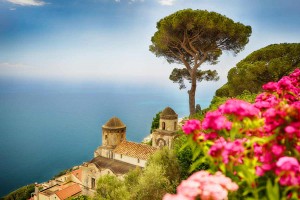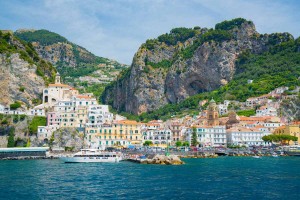
©Bigstock.com/Denis Tabler
The extraordinary beauty of the region Campania spawns many stunning villages, towns and landscapes – you’re certainly already familiar with Naples, Pompei and Mount Vesuvius, just to name a few. Such a list absolutely must include the Amalfi Coast as well. The coastal strip at the Salerno Gulf is part of the Sorrentine Peninsula and is made up of 13 fascinating municipalities – some idyllic and sleepy, some quite lively – as well as stunning natural sceneries between tall rocks and the deep-blue sea. An area of an astonishing 11,231 ha was declared UNESCO World Heritage Site in 1997. Join us on a little trip to the coast!
Nature and economy
The UNESCO committee named the Amalfi Coast a place of extraordinary beauty and natural diversity colliding with the exciting architecture and multifaceted art of the individual municipalities in a fascinating manner. The coastal region already blossomed in medieval times, which you can see in many a village. Still, living space is fairly limited due to the particularly steep coastal location, not to mention the heavily limited agricultural production space.
As such, most villages and towns of the Amalfi Coast primarily focus on tourism, the biggest economic factor of the region by far. Awe-inspiring art treasures, idyllic peace, long-running hiking trails and glorious views make holiday dreams come true. But that’s not all. Lemons are grown on the terraces above the sea, their peels being used to produce excellent Limoncello – tastings are most definitely an option. Additionally, the coastal region is also home to fine wines. Red wines, white wines and rosés display a wide variety of different taste with many a surprising flavour.
Municipalities at the Amalfi Coast

©Bigstock.com/Paul Brady
One single road leads through the entire Amalfi Coast. Strada Statale 163, probably better known to you as the Amalfitana, runs for 50 km from Meta di Sorrento to Vietri sul Mare. While the view from the steeply sloping coast is pretty breath-taking, the drive on the narrow, hardly two-lane route sections with overhanging rocks can be quite the thrill. Large busses may only travel the Amalfitana with special approval and caravan sets are only allowed to drive at night. And don’t even get us started on the narrow hairpin turns to Ravello.
For now, let’s take a deep breath, because we want to present the 13 municipalities of the Amalfi Coast to you and start with the three most important villages and towns.
Amalfi
First, we send you to Amalfi, the place that gave this region its name. The small town was apparently founded by Emperor Constantine’s soldiers around 320 AD and quickly became a maritime trade power before Pisan attacks and a severe earthquake led to political and economic dependence.
Now Amalfi, which stretches across steep hills, is known as a touristic hotspot and home of particularly excellent Limoncello, which you can try and savour in the numerous cafés, bars and restaurants. Additionally, there’s lots of art and culture to discover in this town. The Cathedral on Piazza Duomo has 11th century roots and was initially converted to Arab-Norman, later to baroque style. This glorious building with a colourful mosaic façade and three-nave interior with the remains of the apostle St. Andrew is the town’s landmark. Furthermore, we recommend a brief trip to the civic museum in the town hall and the shipping museum in the old shipyard. Both places introduce you to Amalfi’s riveting history.
Positano
Tourism also takes centre stage in the friendly village Positano. Walks through the steep alleys and over numerous stairs to the beach are part of your daily routine. Here you set up camp and swim in the clear water or catch some sun. Mind you, the early bird catches the worm as Positano is a highly popular beach resort. During your walks through an area that was likely inhabited as early as antiquity – excavations unearthed ruins of a Roman villa – you’ll meet cheerful people vested in Positano Moda. This rather rustic style displays strong colours, creative cuts and lots of lace. It has even become a neat little export hit in recent years. Numerous churches, including Santa Maria Assunta with a black Madonna and Santa Caterina, and the rock Montagna Forata with its many holes accompany your relaxed walks.
Ravello
Many centuries ago Roman patrician families supposedly retreated to the hills between the valleys Regina and Dragone when fleeing from the barbarians and founded a small estate. In all actuality, Ravello attracted a rich burgess class that left a decisive mark on the place. During your tour you’ll see numerous splendid, well-preserved villa. 13th century Villa Rufolo is probably the main attraction. This imposing, playful complex of buildings now mostly serves as the backdrop for contemporary exhibitions. Its tremendous garden with numerous smaller buildings provides welcome recreation and gorgeous views. Richard Wagner found inspiration for his Parsifal here. Even more villas, churches and sanctuaries allow you to discover something spectacular and mystical at every corner of Ravello.
Other municipalities at a glance
These three main places on the Amalfi Coast aside, another ten municipalities await you along the Amalfitana. Things are usually a bit quieter here, even sleepy, but just as beautiful. Your trip through the UNESCO World Heritage region leads you to:
- Vietri sul Mare: Colourful ceramics have been made in this small village since medieval times. You absolutely must visit the ceramics museum!
- Cetara: A humongous tower watches over the sleepy village with around 2,000 inhabitants that’s all about fishing and agriculture.
- Maiori: Maiori’s history stretches across many centuries and is palpable at every corner. Look forward to the splendid Palazzo Mezzacapo, Santa Maria a Mare rising high on a rock and Santa Maria Olearia, the Benedictine monastery founded in 973.
- Tramonti: Nuns produce the fine herbal liqueur Concerto in the convent Conservatorio di San Giuseppe e Teresa. Cappella Rupestre, the chapel in the rock, also needs to be visited.
- Minori: What was once a popular holiday destination among Roman aristocracy remains a small but nice touristic village with a stunning Roman villa and the imposing Basilica di Santa Trofimena.
- Scala: The erstwhile bishop’s see of the sea republic Amalfi amazes with the massive 12th century Cathedral. Its now baroque face creates an exciting clash of styles.
- Atrani: Rich merchants of the sea republic had their villas built in Atrani. The now baroque churches San Salvatore de’ Bireto and Santa Maria Maddalena were their places of worship.
- Conca dei Marini: The Etruscans founded one of the most beautiful villages in Italy. Life is delightfully relaxed in the quaint municipality with less than 700 inhabitants.
- Furore: This small municipality on the coast has its own fjord with a breath-taking beach. Furore, too, is among the most beautiful villages in Italy.
- Praiano: Numerous hotels and several imposing churches represent Praiano’s two sides. Discover splendid Renaissance paintings inside San Luca Evangelista.
Whether you’re touring the Amalfitana, tackling one of the numerous hiking trails or head down to the beach after a short walk, the Amalfi Coast is always worth the journey. The gorgeous mix of bustling activity, touristic infrastructure and natural countryside idyll makes holiday dreams come true lining one of the most beautiful UNESCO World Heritage Sites in Italy. Time to get ready for your tour of Campania!